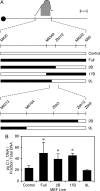The p47 GTPases Igtp and Irgb10 map to the Chlamydia trachomatis susceptibility locus Ctrq-3 and mediate cellular resistance in mice
- PMID: 16959883
- PMCID: PMC1599917
- DOI: 10.1073/pnas.0603338103
The p47 GTPases Igtp and Irgb10 map to the Chlamydia trachomatis susceptibility locus Ctrq-3 and mediate cellular resistance in mice
Abstract
Infections caused by the bacteria Chlamydia trachomatis contribute to diverse pathologies in a variety of human populations. We previously used a systemic model of C. trachomatis infection in mice to map three quantitative trait loci that influence in vivo susceptibility differences between the C57BL/6J and C3H/HeJ inbred strains of mouse. One of these quantitative trait loci, Ctrq-3, influences an IFN-gamma-dependent susceptibility difference in primary embryonic fibroblasts isolated from these strains. Here we use fine structure mapping in congenic fibroblasts carrying DNA from the susceptible parent to localize the effect of Ctrq-3 to a 1.2-megabase interval of genomic DNA that contains Irgb10 and Igtp, two members of the IFN-gamma-inducible p47 family of GTPases. This class of proteins has been widely implicated in resistance to intracellular pathogens in mice. We analyzed expression of Irgb10 and Igtp in parental and congenic embryonic fibroblasts treated with IFN-gamma and found that relatively resistant fibroblasts express more Irgb10 than relatively susceptible fibroblasts. However, we also found that abolishing the expression of either Irgb10 or Igtp increases susceptibility of embryonic fibroblasts to C. trachomatis. Thus, we conclude that, although a difference in Irgb10 expression is likely responsible for the effect of Ctrq-3 on susceptibility to C. trachomatis, both genes play a role in intracellular resistance to C. trachomatis.
Conflict of interest statement
The authors declare no conflict of interest.
Figures





References
-
- Schachter J. In: Chlamydia: Intracellular Biology, Pathogenesis, and Immunity. Stephens RS, editor. Washington, DC: Am Soc Microbiol; 1999. pp. 139–169.
-
- World Health Organization. Global Prevalence and Incidence of Selected Curable Sexually Transmitted Infections: Overview and Estimates. Geneva: WHO; 2001. pp. 1–43.
-
- Hackstadt T. In: Chlamydia: Intracellular Biology, Pathogenesis, and Immunity. Stephens RS, editor. Washington, DC: Am Soc Microbiol; 1999. pp. 101–138.
-
- Fields KA, Hackstadt T. Annu Rev Cell Dev Biol. 2002;18:221–245. - PubMed
Publication types
MeSH terms
Substances
Grants and funding
LinkOut - more resources
Full Text Sources
Medical
Molecular Biology Databases

